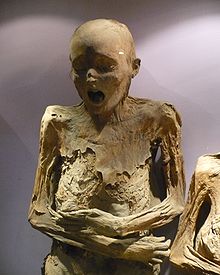- Mummies of Guanajuato
-
The Mummies of Guanajuato are a number of naturally mummified bodies interred during a cholera outbreak around Guanajuato, Mexico in 1833. These mummies were discovered in a cemetery located in Guanajuato, which has made the city one of the biggest tourist attractions in Mexico. All of these mummies were disinterred between 1865 and 1958, when the law required relatives to pay a tax in order to keep the bodies in the cemetery. If the relatives could not pay this tax, they would lose the right to the burial place, and the dead bodies were disinterred. Ninety percent of the bodies in the cemetery were disinterred because their relatives did not pay the tax. However, only 2% of them were naturally mummified. The mummified bodies were stored in a building and in the 1900s the mummies began attracting tourists. Cemetery workers began charging people a few pesos to enter the building where bones and mummies were stored. This place was turned into a museum called El Museo De Las Momias, The Mummies' Museum. A law prohibiting the disinterring of more mummies was passed in 1958, but this museum still exhibits the original mummies.[1]
Contents
Related information
Due to the deadliness of the epidemic, more cemeteries had to be opened in San Cayetano as well as Cañada de Marfil. Many of the bodies were buried immediately to control the spread of the disease; in some cases, the dying were buried alive by accident. As a result, some of the mummies have horrific expressions attesting to their death in the tombs, though most expressions became fixed postmortem. One of the mummies who was buried alive was Ignacia Aguilar. She suffered from a strange sickness that made her heart appear to stop for one day on several occasions. During one of these incidents, her heart appeared to stop for more than the usual time. Thinking she had died, her relatives decided to bury her. When her body was disinterred, it was noticed that she was facing down, biting her arm, and that there was a lot of blood in her mouth.
The first mummy was put on display in 1865. It was the body of Dr. Remigio Leroy. This museum, containing at least 108 corpses, is located above the spot where the mummies were first discovered. Numerous mummies can be seen throughout the exhibition, of varying sizes. This museum is known to have the smallest mummy in the world, a fetus from a pregnant woman who fell victim to cholera. Some of the mummies can be seen wearing parts of their clothing from when they were buried.
The mummies of Gunajuato have been a notable part of Mexican popular culture, fitting nicely in to the national holiday "The Day of the Dead" (El Dia de los Muertos) A well known B movie called Santo vs. The Mummies of Guanajuato (1970) pitted the well-known Mexican professional wrestler Santo and several others in a battle to a predictable finish.
Famous author Ray Bradbury visited the catacombs of Guanajuato with his friend Grant Beach[2] and wrote the short story "Next In Line" about his experience. In the introduction to The Stories of Ray Bradbury he wrote the following about this story: "The experience so wounded and terrified me, I could hardly wait to flee Mexico. I had nightmares about dying and having to remain in the halls of the dead with those propped and wired bodies. In order to purge my terror, instantly, I wrote 'The Next in Line.' One of the few times that an experience yielded results almost on the spot." [3]
In the late 1970s, filmmaker Werner Herzog took footage of a number of the mummies and used it for the title sequence of his film Nosferatu the Vampyre, evidently, in order to create, as potently as possible, a morbid, eerie atmosphere.
In 2007, the Mayor of Guanajuato, Eduardo Hicks, M.D., invited three scientists, including a forensic anthropologist, to do detailed studies of 22 of the museum's mummies. See the references below for a preliminary report and some details of the results of those studied. A final report has yet to be issued and more research is in progress.
Toyah Willcox wrote a song about the mummies in 1980 called "Mummies".[4]
There are 119 mummies on display. The mummies are some of the strangest ones ever put on display. Some are clothed while others only have shoes. There is a wide range on age, from infants to really old.
Other mummies
Other locations in Mexico where the mummification process occurs naturally include:
References
- ^ [1]
- ^ Page xxi of the introduction entitled "Dark Carnival Revisited" from the special Gauntlet Publications edition of "Dark Carnival." Springfield, Pennsylvania: Gauntlet Publications, 2001.
- ^ Page xvii of the introduction entitled "Drunk, and in Charge of a Bicycle," from "The Stories of Ray Bradbury," New York: Alfred A. Knopf, 1980.
- ^ http://www.youtube.com/watch?v=xL2zvhP5FpQ
External links
Categories:- Guanajuato
- Modern Mexico
- Mummies
Wikimedia Foundation. 2010.



